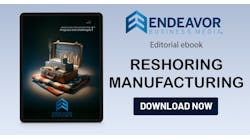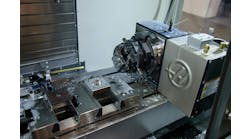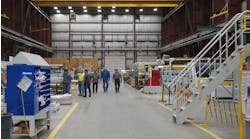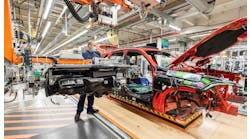The Importance of Procurement Agility: How to Turn Volatility into a Competitive Advantage
It is more important than ever for manufacturers to ask themselves: Does my procurement team employ best-in-class practices, sophisticated tools with the right talent, and the necessary formal and informal cross-functional linkages?
Some 50 to 90 percent of the companies that answer this question will respond “no.” While this realization is a good indication of readiness for change, these organizations should realize that, not only are they missing an opportunity today, but they will not be ready for the challenges the next decade will bring.
McKinsey & Company research has confirmed that procurement pays: Companies with high-performing procurement functions consistently outperform their rivals on a range of financial indicators, and the best companies are building advanced talent management strategies into the very heart of their procurement organizations. Moreover, procurement will play a key role in helping companies cope with the new challenges and opportunities of our increasingly dynamic global economy.
Among the megatrends that McKinsey has identified as the major shapers of the coming decade, one that is particularly crucial for manufacturers is what we call “the volatile new normal.” The tension between rapidly rising resource consumption and environmental sustainability is sure to become one of the next decade’s critical pressure points. As the earth’s resources fluctuate in price—or worse, run out—the reverberations will be felt across the globe.
Chief procurement officers (CPOs) have lost their jobs for not being able to “supply the factory”—the primary objective of any procurement organization and one that is getting harder to master. Responding to the world’s increasing volatility simply by paying insurance premiums is not an option. Instead, procurement must help turn volatility and scarcity into competitive advantage. Ask yourself:
- How transparent are the various risks in our supply chain? Do we know which risks we need to examine more thoroughly, determining those that require mitigating action, and which to accept?
- How adequate are our current business-continuity plans for coping with the most virulent supply risks?
- How can procurement turn better market insight and understanding of risk exposure into a competitive weapon?
Volatility as the New Normal
Consider Honda. While the carmaker’s weighted raw-material index increased by more than 200 percent between 2009 and 2012, the average prices for its cars remained stable. Honda was also hurt in 2011 by the earthquake and tsunami in Japan and floods in Thailand; production facilities located in these regions were hit hard. The carmaker lost sales of 260,000 vehicles as a consequence of the floods alone, resulting in a 59 percent reduction in net profit.
Risk management has already established itself as a key differentiator between procurement leaders and followers. But the prerequisites to risk management will change in the future, and key competencies regarding how companies manage volatility and scarcity will distinguish those who succeed. CPOs and their teams, as the natural owners of risk management, will play a pivotal role in coordinating the required cross-functional preemptive responses.
What are leading organizations, particularly in manufacturing, already doing to protect against—or even gain advantage from—the rising volatility? What distinguishes companies in which procurement is recognized as the gatekeeper of the company’s access to resources and is included in decisions regarding product design and development? What sophisticated tools are they leveraging for both financial and physical risk management? How do they make manufacturing more flexible to increase production during peak times with dedicated suppliers? And how do they become more deeply networked in global sourcing markets to gain foresight into volatility?
Some industries—for instance, airlines, which are highly dependent on kerosene prices—already have considerable experience dealing with extreme price volatility. Lufthansa, for example, had to pay €1 billion more for fuel in 2012 compared with 2011. But for many others, this extreme volatility is new territory. For a consumer goods company like Henkel, raw-material costs as a percentage of sales grew by 22 percent from 2007 through 2011.8
While CPOs and other operations executives face volatility every day from major disruptions and normal operational variability, they are often inadequately prepared to effectively manage their high-priority risks. The key, as volatility becomes the new normal, is for the procurement function to become agile. Agile procurement has a measurable benefit, and entails decision-making that is both strategic as well as operational. As long as reducing costs remained the most important concern, agility was more or less synonymous with improved forecast accuracy. But forecasting alone is no longer enough. To become truly agile, procurement must expand its approach to consider other elements of agility.
The New Model of Agile Procurement
Walmart provides an example of one element of agility: the ability to anticipate change. In 2002, 29 ports on the U.S. West Coast were closed when a breakdown in labor negotiations resulted in a strike. Hundreds of cargo-bearing ships were stranded at sea for ten days until the federal government intervened. Walmart, which had been closely watching the progress of the labor negotiations, was one of only a few companies to anticipate the strike and port closure, preemptively building inventory to protect its supply of goods before the shutdown occurred.
Agile procurement looks for and anticipates uncertainty, rather than just managing the current environment. This entails ongoing monitoring of the key metrics that measure a supplier’s health. It also means identifying an alternative supplier that can be called upon quickly if the original supplier’s risk profile becomes excessive.
For example, a global aircraft builder monitors all of its suppliers with respect to risk—even as far downstream as tier three and tier four. The company has dual sourcing for all key components, even though this reduces leveraging opportunities in contracting. Plus, it knows where its suppliers are located. In contrast, many automotive OEMs were surprised to learn that they were affected by the Fukushima disaster because of exposure to lower-tier suppliers they didn’t know about.
Another key element of agility is time. When a hurricane destroyed 80% of the banana crop in Honduras, the impact hit two global fruit traders hard. But, while one lost 70% of its supply and its revenues fell by 4%, the other was able to boost output from alternative suppliers and actually increased revenues by 4%.
After an incident disrupts supply, leading companies aren’t simply faster than the competition at getting back to normal. They also find ways to use time as a competitive advantage. Being able to react faster than the competition, thereby gaining advantages in cost and market share, will become an increasingly important differentiator.
Cross-functionality is another important element of agility. At one of the leading global manufacturers of flavors and juices, no sales contract is signed until procurement has reviewed the raw-material assumptions. At a global chewing-gum manufacturer, procurement works with the marketing function to decide which particular products to promote at particular times on the basis of raw-material price inputs. The CPO of a leading global food company is actively involved in initiating changes in product recipes, so that the formulation of its products can be altered based on the price levels of raw materials.
One global metals company was able to effectively manage a shortage of key materials while a competitor had to stop production. Prior to the disruption, the successful company had institutionalized collaboration between procurement and manufacturing so that source material could be used in a wider range of quality grades without affecting the finished product’s performance. Preemptive levers were introduced, including: flexible contracts that allowed for adjustments in volumes purchased from individual vendors and vendor sites; investments in internal production capacity that allowed for the blending of lower quality materials from marginal players as “extenders”; a supplier development program to coach suppliers on how to change their refining processes to produce the optimal grade for any given plant. In addition, to improve its detection and response capabilities, the company established market intelligence teams in each region. These teams were responsible for developing an informed point of view about likely changes to the price and availability of commodities, the drivers for those changes, and the implications for the specific business.
Does your procurement team follow the example of this metals company in taking a fully comprehensive view on volatility and preparing a holistic means of dealing with it? It is clear in these examples that manufacturers seeking to benefit from volatility are enhancing the function of procurement and the role of the CPO. They are recognizing that procurement is an early sensor of volatility and, through its reactions, the supply chain’s preemptive risk manager.
Chief procurement officers must consider how they can play a leading role in aligning procurement with corporate strategy. Combining these two general functions—purchasing and alignment—constitutes the next stage in procurement agility for the manufacturers of today and tomorrow.
Peter Spiller is a principal in McKinsey’s Frankfurt, Germany, office and leader of the firm’s EMEA purchasing and supply management practice.
Nicolas Reinecke is a tenured expert principal in McKinsey’s Hamburg, Germany, office.
Drew Ungerman is a director in McKinsey’s Dallas, Texas, office and leads the firm’s Americas purchasing and supply management practice.
Henrique Teixeira is a Principal in McKinsey’s São Paulo, Brazil, office.
This adapted article is excerpted with permission from the publisher from PROCUREMENT 20/20: Supply Entrepreneurship In a Changing World by Peter Spiller, Nicolas Reinecke, Drew Ungerman and Henrique Teixera (Wiley, 2013).




